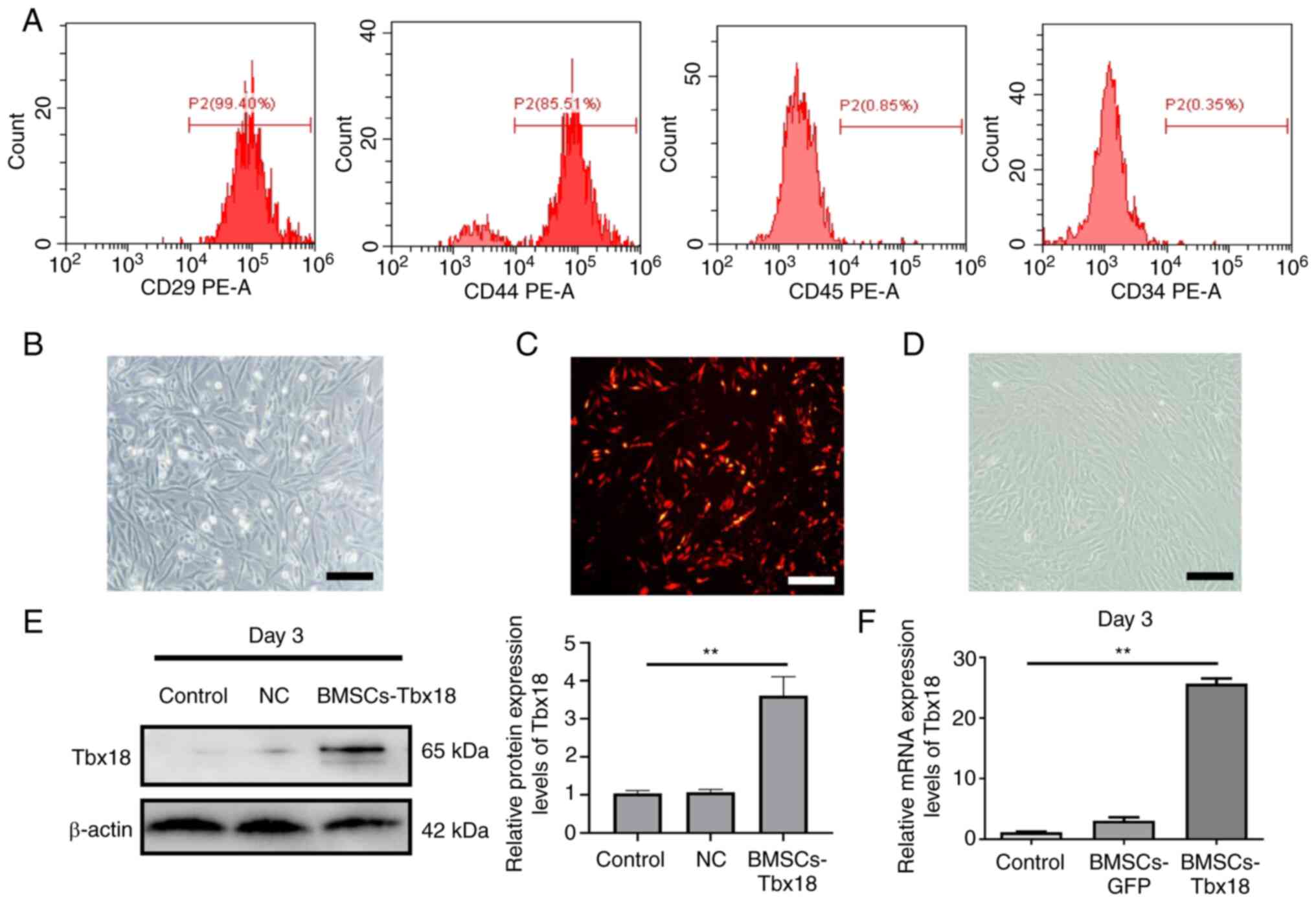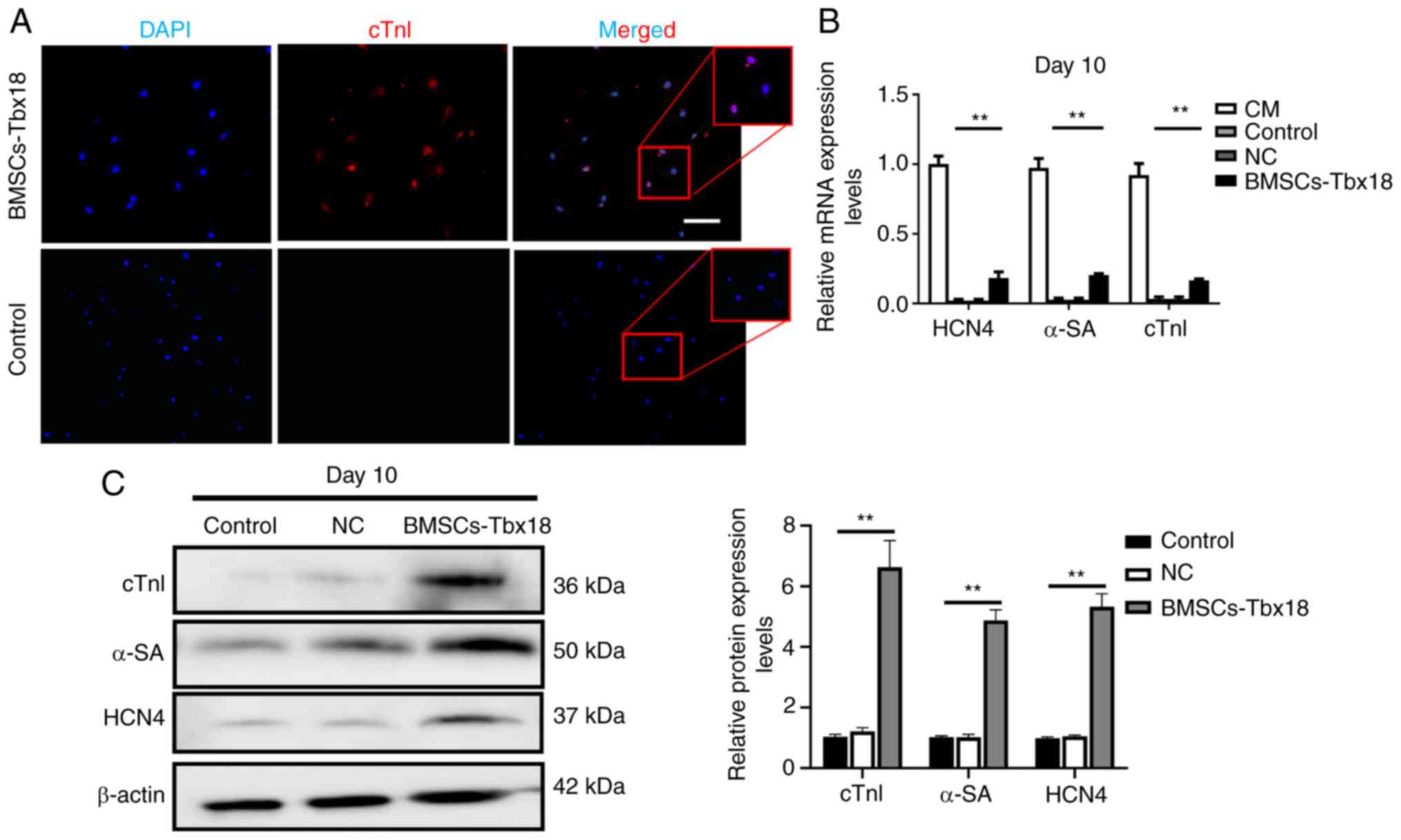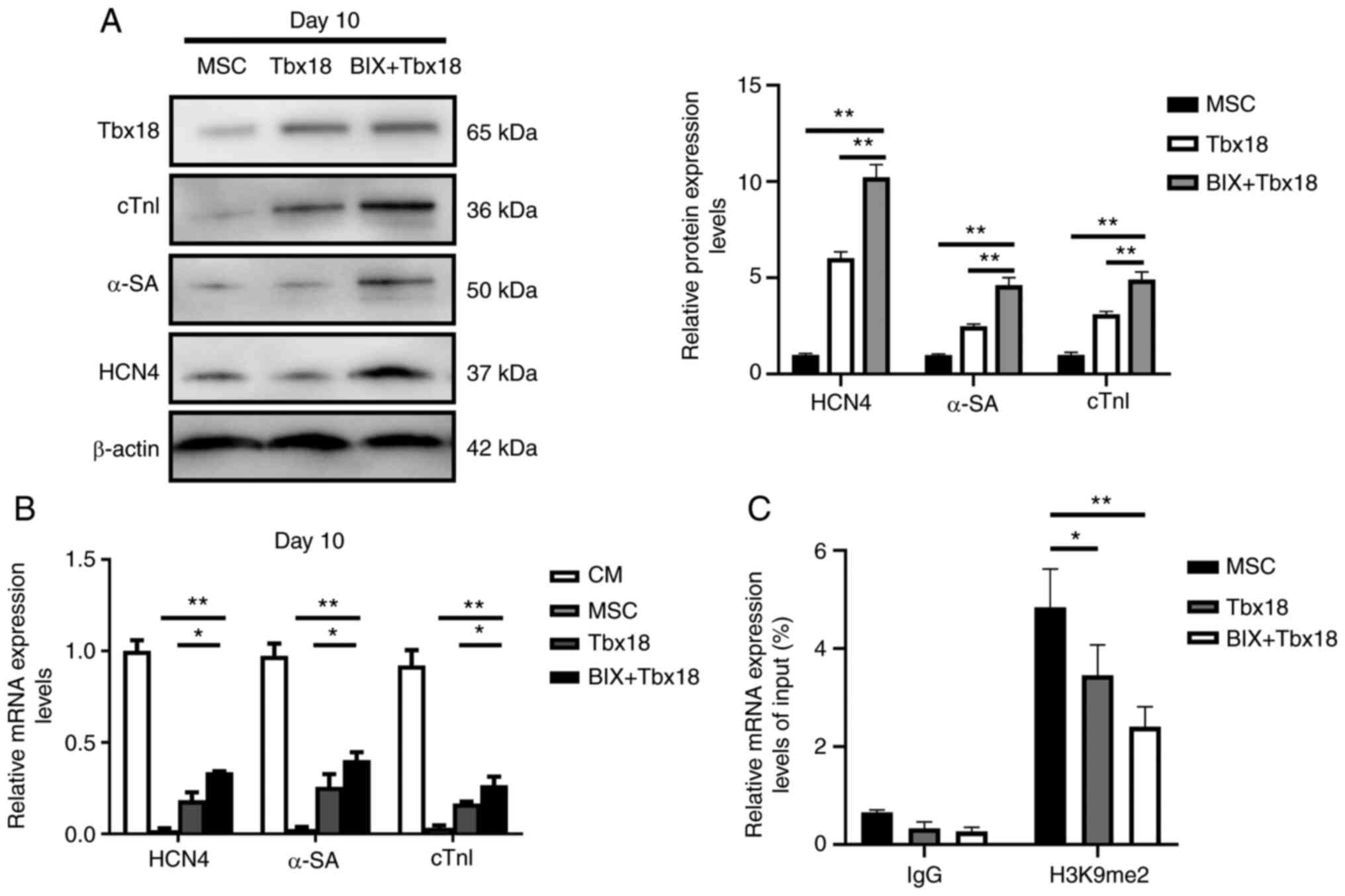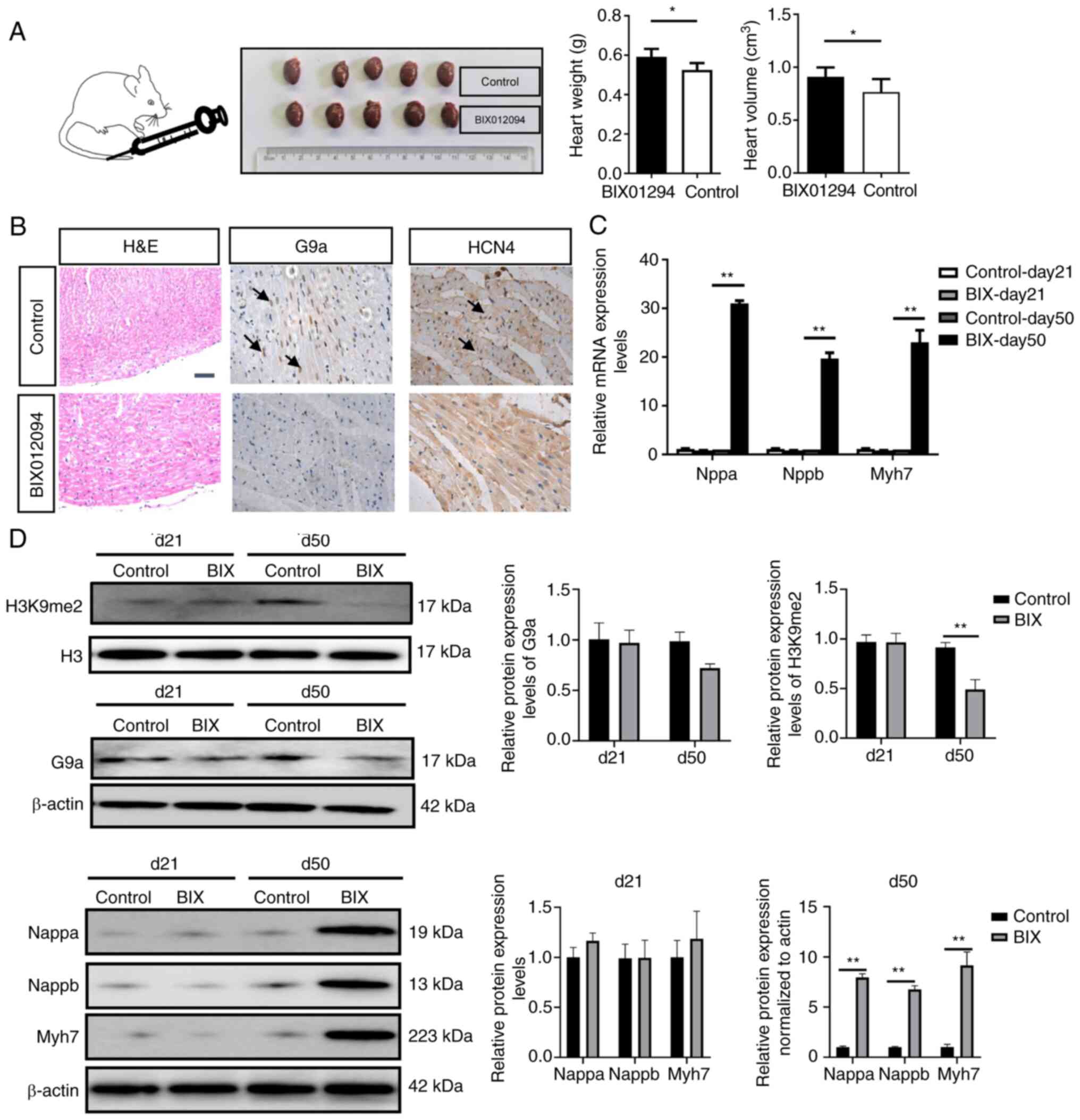|
1
|
Sun X, Li H, Zhu Y, Xu P, Zuo Q, Li B and
Gu X: 5-Azacytidine-induced cardiomyocyte differentiation of very
small embryonic-like stem cells. Stem Cells Int. 2020:51623502020.
View Article : Google Scholar : PubMed/NCBI
|
|
2
|
Farraha M, Kumar S, Chong J, Cho HC and
Kizana E: Gene therapy approaches to biological pacemakers. J
Cardiovasc Dev Dis. 5:502018. View Article : Google Scholar : PubMed/NCBI
|
|
3
|
Li Y, Yang M, Zhang G, Li L, Ye B, Huang C
and Tang Y: Transcription factor TBX18 promotes adult rat bone
mesenchymal stem cell differentiation to biological pacemaker
cells. Int J Mol Med. 41:845–851. 2018.PubMed/NCBI
|
|
4
|
Xiao H, Yang YJ, Lin YZ, Peng S, Lin S and
Song ZY: Transcription factor Tbx18 induces the differentiation of
c-kit+ canine mesenchymal stem cells (cMSCs) into
SAN-like pacemaker cells in a co-culture model in vitro. Am J
Transl Res. 10:2511–2528. 2018.PubMed/NCBI
|
|
5
|
Gorabi AM, Hajighasemi S, Tafti HA, Atashi
A, Soleimani M, Aghdami N, Saeid AK, Khori V, Panahi Y and Sahebkar
A: TBX18 transcription factor overexpression in human-induced
pluripotent stem cells increases their differentiation into
pacemaker-like cells. J Cell Physiol. 234:1534–1546. 2019.
View Article : Google Scholar : PubMed/NCBI
|
|
6
|
Wiese C, Grieskamp T, Airik R, Mommersteeg
MT, Gardiwal A, de Gier-de Vries C, Schuster-Gossler K, Moorman AF,
Kispert A and Christoffels VM: Formation of the sinus node head and
differentiation of sinus node myocardium are independently
regulated by Tbx18 and Tbx3. Circ Res. 104:388–397. 2009.
View Article : Google Scholar : PubMed/NCBI
|
|
7
|
Szabo E, Rampalli S, Risueño RM, Schnerch
A, Mitchell R, Fiebig-Comyn A, Levadoux-Martin M and Bhatia M:
Direct conversion of human fibroblasts to multilineage blood
progenitors. Nature. 468:521–526. 2010. View Article : Google Scholar : PubMed/NCBI
|
|
8
|
Hu Y, Li N, Liu L, Zhang H, Xue X, Shao X,
Zhang Y and Lang X: Genetically modified porcine mesenchymal stem
cells by lentiviral Tbx18 create a biological pacemaker. Stem Cells
Int. 2019:36213142019. View Article : Google Scholar : PubMed/NCBI
|
|
9
|
Thienpont B, Aronsen JM, Robinson EL,
Okkenhaug H, Loche E, Ferrini A, Brien P, Alkass K, Tomasso A,
Agrawal A, et al: The H3K9 dimethyltransferases EHMT1/2 protect
against pathological cardiac hypertrophy. J Clin Invest.
127:335–348. 2017. View
Article : Google Scholar : PubMed/NCBI
|
|
10
|
Livak KJ and Schmittgen TD: Analysis of
relative gene expression data using real-time quantitative PCR and
the 2(−Delta Delta C(T)) method. Methods. 25:402–408. 2001.
View Article : Google Scholar : PubMed/NCBI
|
|
11
|
Kaur K, Yang J, Edwards JG, Eisenberg CA
and Eisenberg LM: G9a histone methyltransferase inhibitor BIX01294
promotes expansion of adult cardiac progenitor cells without
changing their phenotype or differentiation potential. Cell Prolif.
49:373–385. 2016. View Article : Google Scholar : PubMed/NCBI
|
|
12
|
Yang J, Kaur K, Edwards JG, Eisenberg CA
and Eisenberg LM: Inhibition of histone methyltransferase, histone
deacetylase, and β-catenin synergistically enhance the cardiac
potential of bone marrow cells. Stem Cells Int. 2017:34649532017.
View Article : Google Scholar : PubMed/NCBI
|
|
13
|
Huang YL, Qiu RF, Mai WY, Kuang J, Cai XY,
Dong YG, Hu YZ, Song YB, Cai AP and Jiang ZG: Effects of
insulin-like growth factor-1 on the properties of mesenchymal stem
cells in vitro. J Zhejiang Univ Sci B. 13:20–28. 2012. View Article : Google Scholar : PubMed/NCBI
|
|
14
|
Kapoor N, Liang W, Marbán E and Cho HC:
Direct conversion of quiescent cardiomyocytes to pacemaker cells by
expression of Tbx18. Nat Biotechnol. 31:54–62. 2012. View Article : Google Scholar : PubMed/NCBI
|
|
15
|
Schweizer PA, Darche FF, Ullrich ND,
Geschwill P, Greber B, Rivinius R, Seyler C, Müller-Decker K,
Draguhn A, Utikal J, et al: Subtype-specific differentiation of
cardiac pacemaker cell clusters from human induced pluripotent stem
cells. Stem Cell Res Ther. 8:2292017. View Article : Google Scholar : PubMed/NCBI
|
|
16
|
Chen L, Deng ZJ, Zhou JS, Ji RJ, Zhang X,
Zhang CS, Li YQ and Yang XQ: Tbx18-dependent differentiation of
brown adipose tissue-derived stem cells toward cardiac pacemaker
cells. Mol Cell Biochem. 433:61–77. 2017. View Article : Google Scholar : PubMed/NCBI
|
|
17
|
Wang F, Zhao H, Yin L, Tang Y, Wang X,
Zhao Q, Wang T and Huang C: Transcription factor TBX18 reprograms
vascular smooth muscle cells of ascending aorta to pacemaker-like
cells. DNA Cell Biol. 38:1470–1479. 2019. View Article : Google Scholar : PubMed/NCBI
|
|
18
|
Wu L, Du J, Jing X, Yan Y, Deng S and Hao
Z: Bone morphogenetic protein 4 promotes the differentiation of
Tbx18-positive epicardial progenitor cells to pacemaker-like cells.
Exp Ther Med. 17:2648–2656. 2019.PubMed/NCBI
|
|
19
|
DiFrancesco D: The role of the funny
current in pacemaker activity. Circ Res. 106:434–446. 2010.
View Article : Google Scholar : PubMed/NCBI
|
|
20
|
Yang G, Tian J, Feng C, Zhao LL, Liu Z and
Zhu J: Trichostatin a promotes cardiomyocyte differentiation of rat
mesenchymal stem cells after 5-azacytidine induction or during
coculture with neonatal cardiomyocytes via a mechanism independent
of histone deacetylase inhibition. Cell Transplant. 21:985–996.
2012. View Article : Google Scholar : PubMed/NCBI
|
|
21
|
Sun X, Gu X, Li H, Xu P, Li M, Zhu Y, Zuo
Q and Li B: H3K9me2 regulates early transcription factors to
promote mesenchymal stem-cell differentiation into cardiomyocytes.
Mol Med Rep. 24:6162021. View Article : Google Scholar : PubMed/NCBI
|
|
22
|
Hayes M and Zavazava N: Strategies to
generate induced pluripotent stem cells. Methods Mol Biol.
1029:77–92. 2013. View Article : Google Scholar : PubMed/NCBI
|
|
23
|
Snowden AW, Gregory PD, Case CC and Pabo
CO: Gene-specific targeting of H3K9 methylation is sufficient for
initiating repression in vivo. Curr Biol. 12:2159–2166. 2002.
View Article : Google Scholar : PubMed/NCBI
|
|
24
|
Sasidharan Nair V, El Salhat H, Taha RZ,
John A, Ali BR and Elkord E: DNA methylation and repressive H3K9
and H3K27 trimethylation in the promoter regions of PD-1, CTLA-4,
TIM-3, LAG-3, TIGIT, and PD-L1 genes in human primary breast
cancer. Clin Epigenetics. 10:782018. View Article : Google Scholar : PubMed/NCBI
|
|
25
|
Collins RE, Tachibana M, Tamaru H, Smith
KM, Jia D, Zhang X, Selker EU, Shinkai Y and Cheng X: In vitro and
in vivo analyses of a Phe/Tyr switch controlling product
specificity of histone lysine methyltransferases. J Biol Chem.
280:5563–5570. 2005. View Article : Google Scholar : PubMed/NCBI
|
|
26
|
Kubicek S, O'Sullivan RJ, August EM,
Hickey ER, Zhang Q, Teodoro ML, Rea S, Mechtler K, Kowalski JA,
Homon CA, et al: Reversal of H3K9me2 by a small-molecule inhibitor
for the G9a histone methyltransferase. Mol Cell. 25:473–481. 2007.
View Article : Google Scholar : PubMed/NCBI
|
|
27
|
Son HJ, Kim JY, Hahn Y and Seo SB:
Negative regulation of JAK2 by H3K9 methyltransferase G9a in
leukemia. Mol Cell Biol. 32:3681–3694. 2012. View Article : Google Scholar : PubMed/NCBI
|
|
28
|
Yang J, Kaur K, Ong LL, Eisenberg CA and
Eisenberg LM: Inhibition of G9a histone methyltransferase converts
bone marrow mesenchymal stem cells to cardiac competent
progenitors. Stem Cells Int. 2015:2704282015. View Article : Google Scholar : PubMed/NCBI
|
|
29
|
Hou P, Li Y, Zhang X, Liu C, Guan J, Li H,
Zhao T, Ye J, Yang W, Liu K, et al: Pluripotent stem cells induced
from mouse somatic cells by small-molecule compounds. Science.
341:651–654. 2013. View Article : Google Scholar : PubMed/NCBI
|
|
30
|
Kim HT, Jeong SG and Cho GW: G9a
inhibition promotes neuronal differentiation of human bone marrow
mesenchymal stem cells through the transcriptional induction of
RE-1 containing neuronal specific genes. Neurochem Int. 96:77–83.
2016. View Article : Google Scholar : PubMed/NCBI
|
|
31
|
Mezentseva NV, Yang J, Kaur K, Iaffaldano
G, Rémond MC, Eisenberg CA and Eisenberg LM: The histone
methyltransferase inhibitor BIX01294 enhances the cardiac potential
of bone marrow cells. Stem Cells Dev. 22:654–667. 2013. View Article : Google Scholar : PubMed/NCBI
|


















